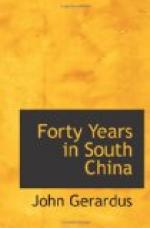In this connection an extract from Dr. David Abeel’s[*] diary may be of value.
[Footnote *: David Abeel was the founder of the American Reformed Mission at Amoy in 1842.]
“Today had a conversation with one of the merchants who come to Kolongsu for trade, on the subject of female infanticide. Assuming a countenance of as much indifference as possible, I asked him how many of his own children he had destroyed: he instantly replied, ‘Two.’ I asked him whether he had spared any. He said, ‘One I have saved.’ I then inquired how many brothers he had. ‘Eight,’ was the answer. I asked him how many children his eldest brother had destroyed. ‘Five or six.’ I inquired of the second, third and all the rest; some had killed four or five, some two or three, and others had none to destroy. I then asked how many girls were left among them all. ‘Three,’ was the answer. And how many do you think have been strangled at birth? ‘Probably from twelve to seventeen.’ I wished to know the standing and employment of his brothers. One, he said, had attained a literary degree at the public examinations; the second was a teacher; one was a sailor; and the rest were petty merchants like himself. Thus, it was evidently not necessity but a cold inhuman calculation of the gains and losses of keeping them, which must have led these men to take the lives of their own offspring.
“Mr. Boone’s teacher’s sister with her own hand destroyed her first three children successively. The fourth was also a girl, but the mother was afraid to lay violent hands on it, believing it to be one of the previous ones reappearing in a new body.”
“The names of the five districts in the Chinchew prefecture are Tong-an, An-khoe, Chin-kiang, Hui-an and Lam-an. Amoy is situated in the Chin-chew prefect.




